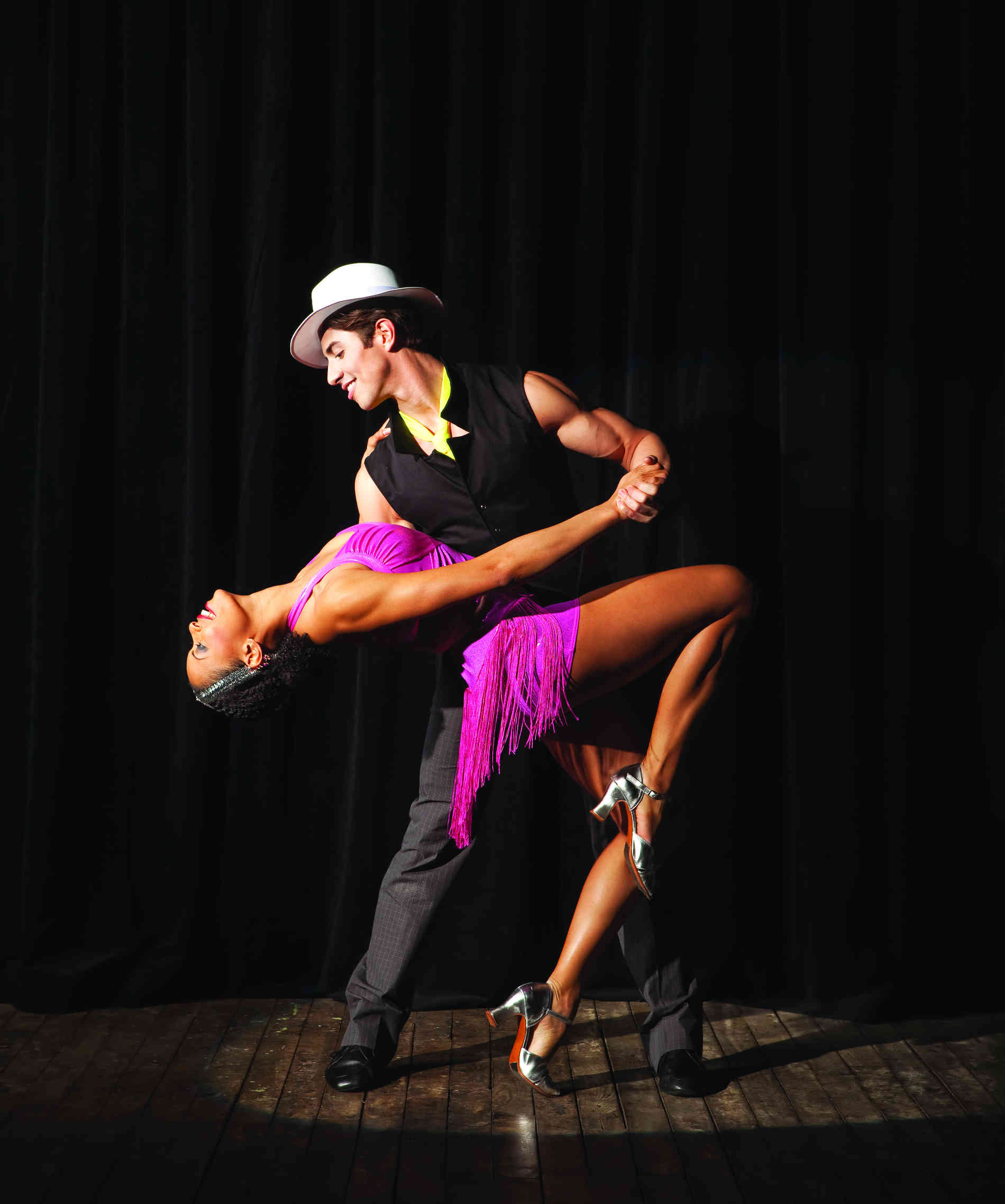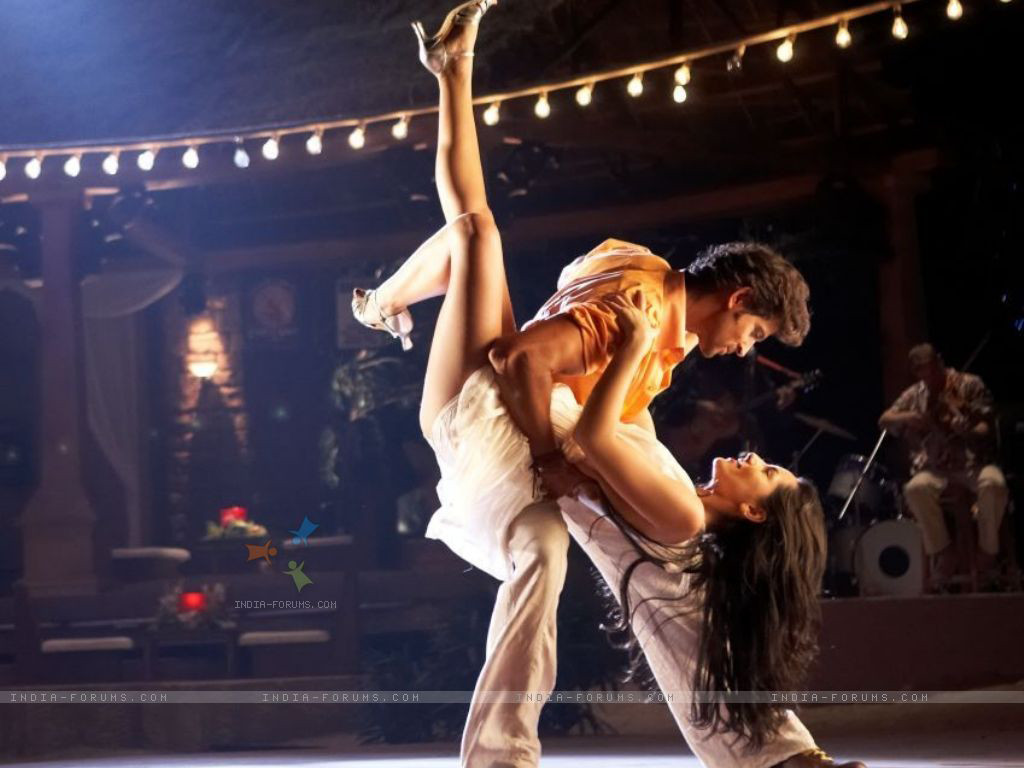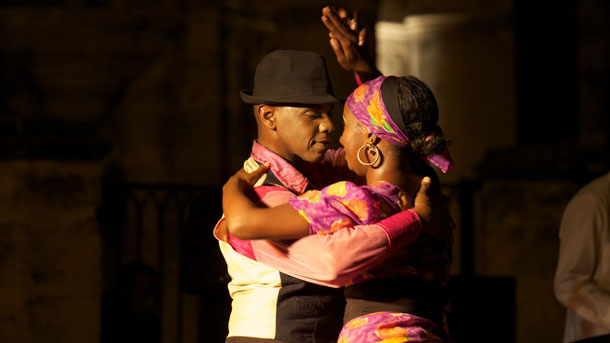Salsa
See also: Categories: Dances, History, Ballroom, DanceSport, Latin
Definition
Overview
Salsa is a dance that was created fairly recently with a mixture of many different styles and musical techniques that all came together in Cuba, land that was home of the many Latin dances and music styles. After achieving popularity in Cuba, visiting musicians from the United States soon became intoxicated with this music and dance style, carrying it back to the States where they kick-started the popular age of Latin music domination that never stopped.Origins
Even though modern Salsa was born in Cuba and Puerto Rico, its origins can be traced back to other lands and earlier parts of our history.Basic components of the Salsa have been brought together by countless immigrants who came into Latin America searching for better life or by those who were brought there against their will, such as African slaves.
By combining the Danzón of French and Haiti immigrants, the Rumbas of African slaves, the Són of the Cuban people, troubadour music of Spanish people (mostly Flamenco) and various musical instruments of Africa, Salsa was performed for the first time during the final years of the 19th century. It was during that time that visitors coming to Cuba first became aware of this new music and dance style, bringing to their home tales of the incredible Latin culture.
Expansion of Salsa to the United States represents one of the most important points in the history of this dance. American soldiers were first who became aware of Salsa during the Cuban War of 1898. After that, Cuba was regularly visited by countless famous American jazz musicians who incorporated Latin styles into their performances. By 1909, Cuban musicians started creating their first radio recordings, which quickly found their way to North America, where they coined the term “Salsa” that described a majority of up-beat Latin music that was imported to the US. The use of the term for the dance started in New York.
Salsa dance entered into the peak of its popularity in the 1970s when the influx of Dominican and Puerto Rican workers arrived to the continental US. Their new dancing style was popularized with the exploits of musical stars including Johnny Pacheco, Fania All-Stars, Willie Colon and Reuben Blades.
Description
In many styles of Salsa dancing, as a dancer shifts their weight by stepping, the upper body remains level and nearly unaffected by the weight changes. Weight shifts cause the hips to move. Arm and shoulder movements are also incorporated. The Cuban Casino style of Salsa dancing (see below under "Styles") involves significant movement above the waist, with up-and-down shoulder movements and shifting of the rib cage.The arms are used by the "lead" dancer to communicate or signal the "follower," either in "open" or "closed" position. The open position requires the two dancers to hold one or both hands, especially for moves that involve turns, putting arms behind the back, or moving around each other, to name a few examples. In the closed position, the leader puts the right hand on the follower's back, while the follower puts the left hand on the leader's shoulder.
In the original Latin America form, the forward/backward motion of Salsa is done in diagonal or sideways with the 3-step weight change intact.
In some styles of Salsa, such as the New York style (see below under "Styles"), the dancers remain mostly in front of one another (switching places), while in Latin American styles, such as the Cuban style, the dancers circle around each other, sometimes in 3 points. This circular style is inspired by the Cuban Son, specifically to the beat of Son Montuno in the 1920s. However, as it is a popular music, it is open to improvisation and thus it is continuously evolving.
Styles
New modern Salsa styles are associated and named to the original geographic areas that developed them. There are often devotees of each of these styles outside of their home territory.Characteristics that may identify a style include: timing, basic steps, foot patterns, body rolls and movements, turns and figures, attitude, dance influences and the way that partners hold each other. The point in a musical bar of music where a slightly larger step is taken (the break step) and the direction the step moves can often be used to identify a style.
Incorporating other dance styling techniques into Salsa dancing has become very common, for both men and women: shimmies, leg work, arm work, body movement, spins, body isolations, shoulder shimmies, rolls, as well as even hand styling, acrobatics and lifts.
Latin American styles originate from Puerto Rico, Cuba and the surrounding Caribbean islands including the Dominican Republic, and then expand to Venezuela, Colombia, and the rest of Latin America. Also, there exists the "Miami" style, which is a fusion of some Cuban style elements with elements of various North American dances from the USA.
As decades went on, several distinct styles of Salsa appeared. Here are some of the most popular ones.
Colombian/Cali Style
Cali-Style Salsa, also known as Colombian Salsa, is based on the geographical location of the Colombian City of Cali. Cali is also known as the "Capital de la Salsa" (Salsa's Capital) due to Salsa music being the main genre in parties, nightclubs and festivals in the 21st century.The elements of Cali-Style Salsa were strongly influenced by dances to Caribbean rhythms which preceded Salsa, such as the Pachanga and Boogaloo.
The central feature of this style is the footwork which has quick rapid steps and skipping motions. The Colombian style does not execute Cross-Body Leads or the "Dile Que No" as seen in other styles, but rather the "step in place and displace" in closed position.
The footwork is intricate and precise, helping several Colombian Style dancers win major world championships.
Cali hosts many annual salsa events such as the World Salsa Cali Festival and the Encuentro de Melomanos y Coleccionistas.
Cuban Style/Casino
In Cuba, a popular dance known as the Casino was marketed as Cuban-Style Salsa or Salsa Cubana abroad to distinguish it from other Salsa styles when the name was popularized in the 70's. Casino is popular in many places around the world, including in Europe, Latin America, North America, and even in some countries in the Middle East such as Israel.Dancing Casino is an expression of popular social culture; Cubans consider Casino as part of social and cultural activities centering on their popular music. The name Casino is derived from the Spanish term for the dance halls, "Casinos Deportivos" where a lot of social dancing was done among the better off, white Cubans during the mid-20th century and onward.
Historically, Casino traces its origin as a partner dance from the Cuban Son, Cha Cha Cha, Danzonand Guaracha. Traditionally, Casino is danced "a contratiempo". This means that, distinct from subsequent forms of Salsa, no step is taken on the first and fifth beats in each clave pattern and the fourth and eighth beat are emphasized. In this way, rather than following a beat, the dancers themselves contribute in their movement, to the polyrythmic pattern of the music. At the same time, it is often danced "a tiempo", although both "on3" (originally) and "on1" (nowadays).
What gives the dance its life, however, is not its mechanical technique, but understanding and spontaneous use of the rich Afro-Cuban dance vocabulary within a "Casino" dance. In the same way that a "sonero" (lead singer in Son and Salsa bands) will "quote" other, older songs in their own, a "Casino" dancer will frequently improvise references to other dances, integrating movements, gestures and extended passages from the folkloric and popular heritage. This is particularly true of African descended Cubans. Such improvisations might include extracts of the Rumba, dances for African deities, the older popular dances such as the Cha Cha Cha and Danzon as well as anything the dancer may feel.
Miami-Style Casino
Developed by Cuban immigrants to Florida and centered on Miami, the Miami-Style Casino is a fusion of some elements from Casino with lots of elements from American culture and dances.The major difference of Miami-style from other North American styles is the "Atras" or "Diagonal", back breaking steps performed backwards diagonally instead of moving forwards and backwards as seen in the New York style. Dancers do not shift their body weight greatly as seen in other styles. Instead, dancers keep their upper body still, poised and relaxed while the feet execute endless intricacies. The dancer breaks mostly On1.
A major difference of Cali Style and Miami-style is that the latter is exclusively danced on the downbeat (On1) and has elements of shines and show-style added to it, following repertoires of North American Styles.
Miami-style has many adherents, particularly Cuban-Americans and other Latinos based in South Florida.
Rueda de Casino
In the 1950s, Salsa Rueda, or more accurately Rueda de Casino, was developed in Havana, Cuba.Pairs of dancers form a circle ("Rueda" in Spanish means "wheel"), with dance moves called out by one person. Many of the moves involve rapidly swapping partners.
"Rueda de Cuba" is an original type of Rueda, originating from Cuba. It is not as formal as the Rueda de Miami and consists of about 30 calls. It was codified in the 1970s.
"Rueda de Miami" originated in the 1980s from Miami and is a formal style with many rules based on a mix. It is a hybridization of the Rueda de Cuba and North American dance styles, with some routines reflecting American culture (e.g. Coca-cola, Dedo, Adios) which is not found in the traditional Cuban-style Rueda.
Los Angeles Style
The Los Angeles Style ("LA" style) is danced strictly on1, in a slot or line, using elements of various North American and stage dances. It is strongly influenced by the Latin Hustle, Swing, Argentine Tango and Latin Ballroom dancing styles.The LA style places strong emphasis on sensuousness, theatricality and acrobatics. The lifts, stunts and aerial works of today's Salsa shows are derived mostly from the LA style forms with origins in Latin Ballroom dancing styles and Ballet lifts.
The two essential elements of this dance are the forward–backward basic step and the cross-body lead. In this pattern, the leader steps forward on 1, steps to the right on 2-3 while turning 90 degrees counter-clockwise (facing to the left), leaving the slot open. The follower then steps straight forward on 5-6 and turns on 7-8, while the leader makes another 90 degrees counter-clockwise and slightly forward, coming back into the slot. After these 8 counts, the leader and follower have exchanged their positions.
New York Style
The New York Style is danced in an ellipse or a "flat figure 8" on the floor, with the partners facing each other most of the time. Unlike other styles of Salsa, the New York style is danced on the second beat of the music, and the follower steps forward on the first measure of the music, not the leader.The etiquette of the New York Style is strict about remaining in the close dance space, and avoiding traveling, dancing in a sandbox area with a lot of spins, turns and styling. There is greater emphasis on performing "shines" in which dancers separate themselves and dance solo with intricate footwork and styling for a time (suspected origins are from the Swing and New York Tap).
Though he did not create the New York style Salsa, Eddie Torres is credited with popularizing it, and for having the follower step forward on the second beat of the first measure.
There are two distinct developments of New York Salsa as a music and dance genre:
- 1) The primary evolution was the Mambo era which was introduced to New York due to the influx of migrating dissidents from all the Caribbean and other Latin migrants during the Pre/Post Cuban Revolution in the 1950s and 1960s. This era is known as the "Palladium Era". At this time, the music and dance was called the Mambo — connoting the general term without being specific. The most famous dancer during this era was Puerto-Rican descendant Pedro "Cuban Pete" Aguilar, also known "The King of Latin Beat".
- 2) The secondary evolution was during the late 1970s, when Latin Puerto Rican migrants contributed a lot to the New York Salsa development during the "NuYorican" era of Héctor Lavoe, which greatly popularized Salsa and modern Latin music throughout the world. Puerto Rican Salsa superstars were the most important musicians during the era, such as Ray Baretto ("The Godfather") and many others. There are also Salsa artists that transcend both periods, notably the legendary Puerto Rican Tito Puente ("The Mambo King").
These two developments create a fusion of a new Salsa music and dance genre, different from its Latin American and Caribbean counterparts.
The New York style Salsa emphasizes harmony with the percussive instruments in Salsa music, such as the congas, timbales, and clave, since many or all of those instruments often mark the second beat in the music.
Ballroom Salsa
Salsa is a popular style danced in Ballroom Dance studios around the globe. Many enjoy it as a social dance while others take it to the competitive dance floor to show their skills and challenge other dancers for grand prizes. Either way, the dance has become very popular in the Ballroom industry today and continues to capture the attention and interest of dancers of all ages.Controversy
There is some controversy surrounding the origins of the word "Salsa". Some claim that it was based on a cry shouted by musicians while they were playing their music. Others believe that the term was created by record labels to better market their music, who chose the word "Salsa" because of its spicy and hot connotations. Still others believe the term came about because Salsa dancing and music is a mixture of different styles, just like Salsa or "sauce" in Latin American countries is a mixture of different ingredients.













